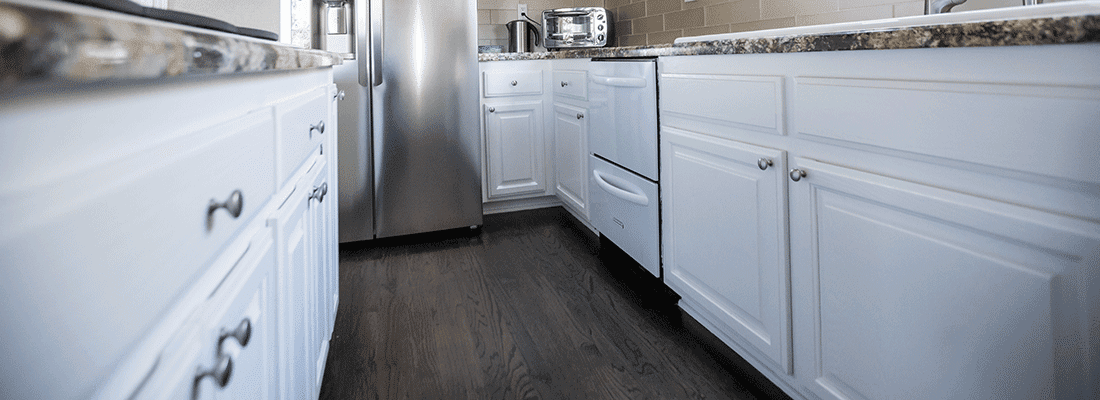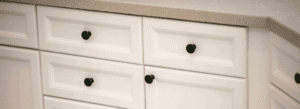Many homeowners wonder how to paint laminate cabinets in a cost-effective manner but with professional quality end results. This certainly can be done but will require more preparation and applications than painting wood. Don’t fall into the trap of thinking that painting laminate follows the same steps as your other painting projects from the past. Laminate isn’t nearly as porous as wood but if you follow the proper process and guidelines, painting your laminate cabinets can turn out to be a lasting accomplishment.
Can you paint laminate cabinets?
Yes, it’s perfectly ok to paint laminate cabinets. But what exactly is laminate anyway? It can basically be any wood-like product such as furniture or cabinets, that is made by attaching a thin layer of printed plastic to a sub-layer of plywood or particleboard. Most often the plastic is printed to look like real wood but could be printed in any pattern or color. Because laminate isn’t as porous as real wood, paint doesn’t absorb or create as tight a bond to its surface. This makes laminate a breeze to wipe down and keep clean, but relatively more difficult to paint.
What is the difference between veneer and laminate?
Veneer and laminate are often confused with one another because they are a very similar concept. They differ because veneered wood has a very thin layer of actual wood applied to the sublayer while laminate is plastic.
Can you paint Formica cabinets?
Formica is simply a brand name of kitchen laminate. The word Formica refers to the company that created this heat-resistant, wipe-clean laminate with melamine resin. It’s the world’s largest manufacturer of high-pressure laminate. Formica was a very popular material for tables and countertops back in the 1950s. It’s still popular in the manufacturing of kitchen cabinets and countertops today due to its heat and scratch-resistant qualities.
How much does it cost to paint kitchen cabinets?
This is a difficult question to answer without knowing specifically what kind of cabinets you’re painting. And of course, painting your cabinets yourself will be significantly cheaper than paying a professional. On average, the cost is anywhere from $3500 to $9000 when hiring out the job. Here is a list of the factors that will play into the overall cost:
- Size of the cabinets
- Damages
- Materials
- What the cabinets are made of
- Quality of paint
How to paint cabinets without sanding
No one enjoys sanding. It’s tedious, messy, time-consuming, and just unpleasant. So, can you get away with skipping the sanding step? You certainly can depending on the situation. If you’re making a change from one newly painted surface to another or painting unvarnished, raw wood, skip the sanding.
If your cabinets have damages, peeling paint, or are covered in varnish or another shiny coating, you’ll need to lightly sand. Scuffing and doing light sanding will help the new paint adhere much better in the long run. The inconvenience will be well worth the results.
Steps to Painting Kitchen Cabinets-Without sanding
- Purchase a cabinet painting kit and the paint of your choice. Be sure to choose a kit that contains a deglosser to help remove any older coats of paint. This deglosser takes away the need to sand or prime surfaces that are already finished.
- Number each cabinet and door front. Before you remove the doors and drawer fronts, tape the corresponding numbers to each one. You may tell yourself that this step isn’t necessary but will inevitably save you some confusion when re-installing them.
- With warm soap and water, carefully wipe down all cabinet surfaces. Pay special attention to areas above your stove where grease can settle in.
- Remove all hardware such as knobs or handles. Keep them in a plastic baggie so they are easy to keep track of.
- Remove cabinet doors and drawer fronts. When working with each individual piece, remove the taped number but keep it nearby so you can keep track easily
- Using a scouring pad, rub on the deglosser. Apply liberally and in the direction of the grain. Wait a few minutes before wiping down thoroughly with a wet rag. Once all the finish is removed, switch to a clean, dry cloth to go over the entire surface again. This should leave you with a matte finish, devoid of shine.
- Mask off any areas in your kitchen you want to be protected from paint. Doing this should allow time for your cabinets to completely dry. 8. Apply the first primer coat to the doors, drawer fronts, and cabinet frames. Once again, apply in the direction of the grain Watch for any drips especially around the edges.
- Let dry for 2 full hours.
- Apply a second coat of primer. Let dry for at least 2 hours. 11. Apply the paint you’ve chosen for your topcoat. We recommend a satin or semi-gloss finish as they add a soft sheen and are very easy to keep clean.
- Let dry for 10-12 hours.
- Reinstall all hinges and hardware.
How to clean painted cabinets
Your kitchen cabinets are the focal point of your kitchen. With that said, people tend to notice when they start to look dirty. Being proactive with your cleaning will keep them looking fresh and beautiful for all to see. You could go out and buy an expensive cabinet cleaner but in reality, dish soap mixed with warm water is the best solution. Dish soap will take care of the grime that tends to build up and is highly effective. Thoroughly wipe down your kitchen cabinets every two weeks with a microfiber cloth. This will make every cleaning a simple one and you will always be prepared for company.
How to Paint Laminate Cabinets Conclusion
If you’re considering painting your kitchen cabinets or have questions regarding any painting projects, contact PaintRite Pros. We make available a wide range of cabinet painting and finishing services in the Sacramento area. We also serve Roseville, Stockton, El Dorado Hills, and more. Some of these services include repainting existing cabinets a new color, providing new cabinets, removing and reconnecting the cabinet hardware, and spray and hand brush options for maximum customization. Whatever your vision is for your cabinets, we’re happy to ensure the final product is everything you imagined.



